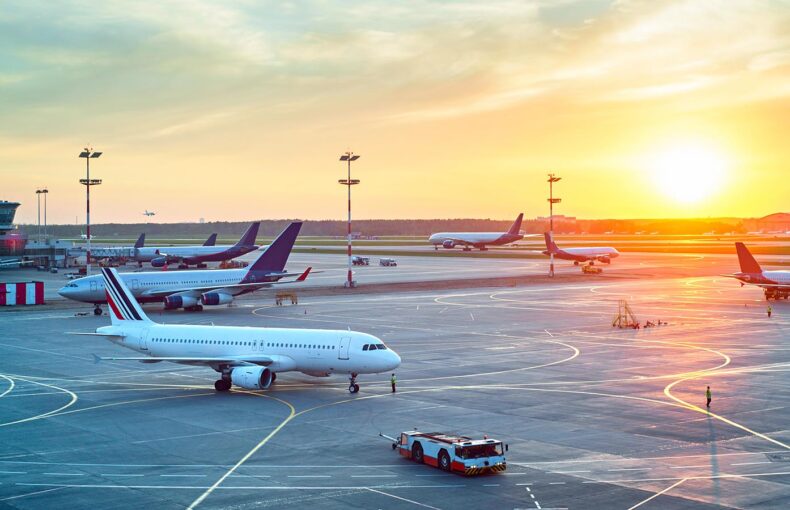From grounded to takeoff: In-depth analysis of air traffic recovery after Covid-19 by regions (2020-2023)
The COVID-19 pandemic has had a significant impact on air traffic density worldwide, as travel restrictions and border closures have led to a sharp decline in the number of flights.
In 2020, the International Air Transport Association (IATA) reported that global passenger traffic had declined by 60% compared to 2019, with airlines losing $126.4 billion in revenue. As countries began to reopen, air traffic is gradually starting to recover. The pace of recovery, however, varies across different regions of the world.
The rapid changes we are witnessing in air travel highlight the need of everyone involved, from airlines to airports, tourism, cargo and logistics, MRO (Maintenance, Repair and Overhaul), and governments, to have reliable aviation data at their fingertips helping them to understand the global trends and to react properly to any arising macro-economic or operational challenges.
Based on aviation insights powered by Spire’s space-based ADS-B data, we performed an analysis of the impact that Covid-19 had on air traffic and also on the post-pandemic recovery per global region. This comprehensive overview looks at air traffic patterns across each of these regions from the early pandemic in 2020 to the beginning of 2023. Let’s have a closer look at our findings.
Discover the importance of aviation data for air cargo during Covid-19
Air traffic overview: North America
North America represents the region least impacted by the pandemic when it comes to air cargo. International and domestic air cargo flights actually increased over 2021-2022. During these two years of air traffic restrictions, we see spikes in domestic air cargo traffic at the end of 2021 and beginning of 2022, most likely connected to the holiday period and the increase in gift deliveries. This trend has continued into 2023 as well.
Much more substantial was the impact of the pandemic on passenger air travel. International passenger traffic dropped by 90% in the beginning of 2020 when travel restrictions were first imposed. Although these numbers are slowly increasing towards pre-pandemic levels, they have not yet reached them at the beginning of 2023. Domestic passenger traffic was four times lower than pre-pandemic levels, but it recovered in 2021 and has remained around the same level since then.
Country in focus: USA
The trends we observed on a regional level are quite similar when looking only at the US. Covid-19 did not significantly impact international and domestic air cargo traffic. In fact, international air cargo has increased over the past three years. The only difference when comparing the North American overview to the United States, is that the US saw a faster recovery in international passenger flights, surpassing the numbers of domestic flights by the end of 2022. This could be attributed to the US border opening to international travelers in November 2021, making it easier to travel to and around the country.
Air traffic overview: South America
Similar to North America, domestic air cargo traffic in South America witnessed a significant increase of 2,5 times more flights over the past two years compared to 2020. This trend continues into 2023 with domestic air cargo remaining 1,5 times higher than in 2020. A similar trend is also observed for international air cargo flights. Their number remained fairly stable during the pandemic with repeated spikes in the number of flights at the beginning of 2021 and 2022. As of today, the number of international air cargo flights has returned to the same level as in 2020.
A positive trend is also observed for domestic and international passenger flights that have returned to 2020 levels, despite their initial stark drop to almost no flights in the second half of 2020.
Air traffic overview: Europe
Europe has been one of the hardest hit regions and saw the sharpest drop in flights when the pandemic started. Compared to the buoyancy of air cargo traffic in the US, air cargo in Europe was heavily impacted by the crisis but was able to swiftly recover in the second half of 2020. We can connect the fast pace with the growing demand for medical supplies (mask, health equipment) needed to fight the pandemic. Domestic air cargo remained relatively stable in subsequent years, but began to drop again in the beginning of 2023, while international air cargo remained at pre-pandemic levels.
Passenger air traffic in Europe also dropped drastically (95%) when internal and international travel restrictions were imposed. Although domestic and international flights began to recover during the summer months due to lower number of cases and reduced restrictions, the second wave of the pandemic caused another drop in November 2020. Europe started to recover at a more stable rate in the middle of 2021, possibly due to higher vaccination rates. Despite a 46.34% recovery rate in the number of flights compared to 2020, Europe has not yet fully recovered from the impact of Covid-19.
Air traffic overview: Asia
Besides Europe, Asia was among the hardest hit regions by the Covid-19 pandemic in terms of air passenger traffic. Both domestic and international flights saw significant drops in 2020 compared to the rest of the world, with domestic passenger flights decreasing by 75% and international flights by 90%. Although flight volumes showed gradual recovery after the initial imposed travel restrictions, numbers have not yet returned to the same level as in 2020. This slow recovery in Asia can be attributed to the prolonged travel restrictions that remained in place longer than in other regions.
However, similar to North America, air cargo traffic was not impacted by the pandemic. Domestic air cargo witnessed a considerable surge, with more than double the number of flights than in 2020 and it managed to remain above pre-pandemic levels. On the international level, air cargo performed above pre-pandemic levels, but dropped off slightly to around the same level as before the pandemic in the beginning of 2023.
Country in focus: China
Upon closer examination of air traffic levels in China, we observe a similar trend in air cargo, which did not appear to be impacted by the Covid-19 pandemic. In fact, domestic flights increased to over three times the pre-pandemic level in 2022, while international air cargo flights almost doubled. In contrast to the regional overview of Asia, China has not experienced an increase in international passenger flights yet, as its borders remained closed until January 2023. Since the lifting of travel restrictions, international passenger flights have started to increase, albeit at a slow pace since this regulatory change has not always been reciprocated across other countries who operated flights to/from China. China’s domestic passenger flow was also affected by internal lockdowns that were introduced over the last two years, leading to multiple months of low flight volumes. As the situation improves, we can see domestic air travel returning to pre-pandemic levels in 2023.
Air traffic overview: Africa
Out of all the regions analyzed, Africa showed the quickest recovery in outbound flights with a year-over-year increase of 135%. However, compared to other regions, Africa also experienced the biggest decrease in both passenger and air cargo traffic during the pandemic. In the second half of 2020, domestic and international passenger flights were virtually nonexistent. As 2021 progressed, both started to pick up, with domestic flight numbers surpassing those of 2020 and international flights reaching nearly the same level.
Similarly, there was a drop in international and domestic air cargo flights. Domestic air cargo traffic had already returned to 2020 levels by the second half of 2021. There has however been a noticeable decrease in the number of flights at the beginning of 2023. International air cargo traffic never surpassed pre-pandemic levels until 2023, when we can observe a drop in the number of flights as well.
Air traffic overview: Oceania
With an 81,26% increase in outbound flights compared to 2021 and 102,25% compared to 2020, Oceania has placed itself as the fifth most connected region in the world. International air cargo traffic in the region remained largely unaffected by the pandemic, while domestic air cargo flights saw a 50% decline in mid-2020, only to quickly recover and exceed pre-pandemic levels by 50% in the second half of the same year.
However, passenger traffic in the region fell drastically by almost 90%, ten times lower than the pre-pandemic level. Since Oceania was one of the regions that was slower to reopen international borders to foreigners, international passenger flights have been slowly recovering since 2020, with the number of flights beginning to pick up in 2022. In the beginning of this year, international flights still remained 40% below pre-pandemic levels.
On the other hand, domestic passenger flights saw a considerable increase in 2021 but only returned to pre-pandemic levels in the second half of 2022, when internal travel restrictions within the region began to ease.
Country in focus: Australia
Similar trends in air cargo and passenger air traffic can also be observed in Australia, the largest country in Oceania. In terms of international passenger flights, a steady recovery is evident following the reopening of borders to foreigners in February 2022, resulting in a 75% increase in the number of international flights over the course of a year. Domestic passenger traffic began to recover at the end of 2020, but experienced a significant drop in the middle of 2021.
2023 will continue to be a year of recovery
The Covid-19 pandemic has had a significant impact on the air traffic industry, with both air cargo and passenger flights being affected. While air cargo flights were less impacted than passenger flights, all regions experienced a decrease in domestic and international passenger flights due to the travel restrictions imposed globally.
The recovery of air traffic has been uneven across different regions, depending on the pace with which restrictions have been eased. North and South America are currently the best-performing regions, with both air cargo and passenger flights surpassing pre-pandemic levels. However, Asia and Oceania are experiencing a slower recovery, with passenger flights starting to pick up only recently. Europe is also among the regions that has not yet fully recovered from the pandemic, despite a 46.34% increase in the number of flights compared to 2020.
Helping you take action with in-depth space-based ADS-B insights
With the help of space-based ADS-B data, aviation professionals can monitor and analyze flight volumes, better understand changes in supply/demand across route networks, analyze airspace usage to optimize operations and reduce costs, predict available capacity, and can ultimately proactively plan their strategies.
Spire Aviation’s satellite constellation collects ADS-B signals across the planet, tracking aircraft even while they cross oceans, deserts, and mountains. On average, Spire’s combination of satellite and terrestrial-based aviation data captures over 200 million positional updates and tracks over 150,000 flights per day.
With the help of reliable and quality real-time and historic aviation data, you can better understand your customer needs and develop strategies that will help you succeed in a competitive aviation market.
 Written by
Written by


